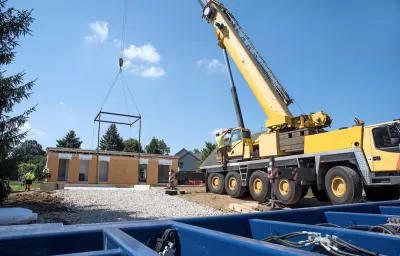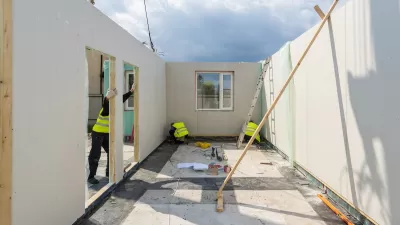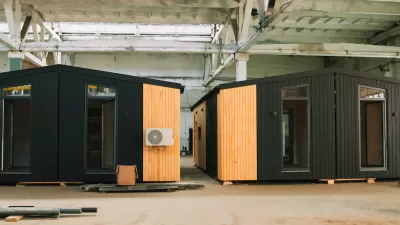Modular housing can be built faster and at lower cost than traditional homes, but the industry is stymied by regulatory and other barriers.

A report published by the Center for American Progress outlines the benefits of modular home construction and how, with some support, the industry could help bring more housing to market in the United States. “Modular homes are constructed off-site, but in contrast to manufactured housing, they are assembled on-site and attached to a permanent foundation,” the report explains.
“Modular construction has many potential benefits, including cost savings, shorter development timelines, and an overall safer and more efficient development process.” However, modular construction is growing slowly in the United States due to barriers that include “financing and payment schedules; scarcity of manufacturers; lack of consistency in local jurisdictions’ building codes, zoning regulations, and state transportation requirements; and labor shortage.”
The report makes several suggestions for boosting modular building. These include:
- Expand financial resources for the modular construction of affordable housing
- Standardize building codes and land use to facilitate production and project approvals
- Support a more diverse workforce and higher wages in modular construction jobs
- Expand the capacity of modular building
The report concludes that “Modular building, if brought to scale, has the potential to reduce construction costs and make it more affordable to build new homes, especially in areas experiencing severe affordable housing shortages.”
FULL STORY: Increasing Affordable Housing Stock Through Modular Building

Planetizen Federal Action Tracker
A weekly monitor of how Trump’s orders and actions are impacting planners and planning in America.

Canada vs. Kamala: Whose Liberal Housing Platform Comes Out on Top?
As Canada votes for a new Prime Minister, what can America learn from the leading liberal candidate of its neighbor to the north?

The Five Most-Changed American Cities
A ranking of population change, home values, and jobs highlights the nation’s most dynamic and most stagnant regions.

‘Quality Work, Fast’: NC Gears up for Homebuilding After Helene, Trying to Avoid Past Pitfalls
The state will field bids to demolish, repair and rebuild homes in the mountains. After struggles in eastern NC, officials aim to chart a different course.

Washington State’s Parking Reform Law Could Unlock ‘Countless’ Acres for New Housing
A law that limits how much parking cities can require for residential amd commercial developments could lead to a construction boom.

Wildlife Rebounds After the Eaton Fire
Following the devastation of the Eaton Fire, the return of wildlife and the regrowth of native plants are offering powerful signs of resilience and renewal.
Urban Design for Planners 1: Software Tools
This six-course series explores essential urban design concepts using open source software and equips planners with the tools they need to participate fully in the urban design process.
Planning for Universal Design
Learn the tools for implementing Universal Design in planning regulations.
Central Transportation Planning Staff/Boston Region MPO
Heyer Gruel & Associates PA
Institute for Housing and Urban Development Studies (IHS)
City of Grandview
Harvard GSD Executive Education
Regional Transportation Commission of Southern Nevada
Toledo-Lucas County Plan Commissions





























